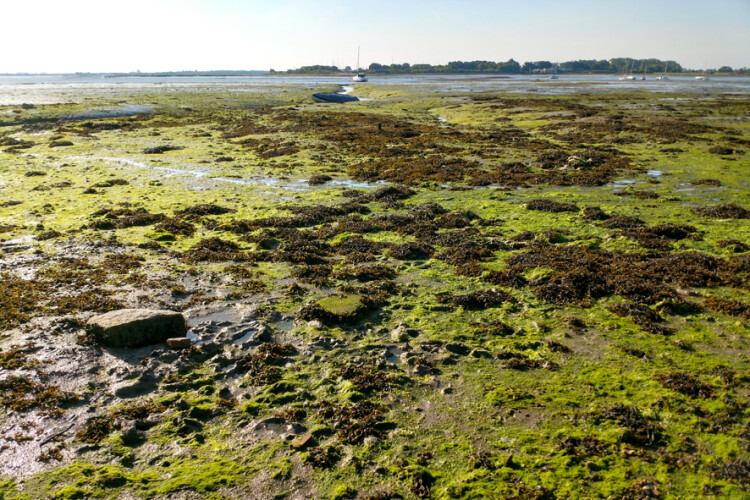When Natural England issued guidance in June 2019 aimed at preventing nitrates from polluting environmentally sensitive areas, few in the construction industry took much notice. But that soon changed.
The advice followed two rulings from the Court of Justice of the European Union on how the Habitats Directive was interpreted. The directive is aimed at safeguarding vulnerable ecologies – one of which, the Solent & Southampton Water Special Protection Area (SPA) – has been badly affected by elevated levels of nitrates running off the land.
The effects of these high levels of nutrient include excessive growths of green algae smothering rare habitats and wildlife, including the Solent’s internationally protected estuaries, salt marshes and seagrass beds, as well as protected birds such as curlews.
As a non-departmental public body controlled by the Department for Environment, Food & Rural Affairs (Defra), Natural England’s guidance carried weight. And as Christian Silk, head of strategic infrastructure planning at consultant Foot Anstey, explains: “What Natural England did was effectively put in place a moratorium on building. House-builders had to prove that development was nitrate-neutral, which was impossible.”
This article was first published in the Oct/Nov 2020 issue of The Construction Index magazine. Sign up online.
Councils in Portsmouth, Fareham, Gosport, Havant and East Hampshire stopped granting planning permission for projects that could damage the Solent unless they included proposals to mitigate the damage done by nitrates.
The house-building industry was soon up in arms amid claims that more than 10,000 new homes were being held back. And pretty soon there was an outbreak of mudslinging and the air became thick with accusations like muck from a farmer’s spreader.
The agricultural simile is deliberate – because the construction industry is being punished for a problem not of its making, a fact that soon became clear: the nitrates come from an accumulation of chemical fertilisers in the soil.
“Portsmouth nitrate levels have been caused by farming decades ago,” protested Penny Mordaunt, Conservative MP for Portsmouth North. “All this is doing is crushing the construction industry and failing to build much-needed homes on brownfield sites.”
Naturally, the National Farmers Union defended its members: “The issue of nitrates is historic and nitrogen applications have been drastically reduced in recent years,” it said. “Farmers can only afford to use nitrogen in a targeted way where it is needed most.”
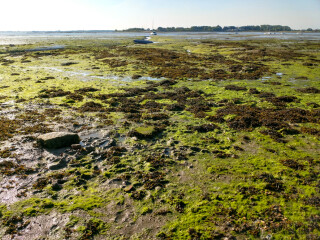
Perhaps the obvious solution would be for the local water company, Southern Water, to extract nitrates from the water flowing both into and out of new homes. But the likelihood of that happening any time soon seems remote: last year Southern Water was fined a record £126m by industry regulator Ofwat over what it described as shocking failures at its sewage treatment sites that polluted rivers and beaches in southern England.
A spokesperson for Southern Water said: “Nitrates can come from a number of sources, chiefly agriculture and wastewater treatment discharges, so potentially any new development connected to a wastewater treatment works could further contribute to the problem.
“The reality is that the vast majority of nutrients, including nitrates which enter the Solent come from agricultural run-off and other diffuse sources.”
Penalised for a problem that was not of their making, contractors and developers were up in arms. “They are saying that house-building is exacerbating the problem, but I’d say there is a strong argument that it isn’t,” says Kieran Walker, technical director of the Home Builders Federation (HBF). “It’s never been proven that house-building increases the level of nitrates in the water.”
In an attempt to get to the bottom of the problem, The Construction Index sent the Defra a list of questions on nitrates. The department’s response – when it finally came – was to reissue an old press statement on the topic. The key question of whether there is any scientific evidence that house-building causes more nitrates than farming was completely ignored.
What is clear is that the problem of nitrate pollution, though not of the construction industry’s making, is not going to go away. But how big is the problem and how can nitrates be mitigated or offset to allow work to carry on?
Although the HBF estimates the number of units delayed at more than 10,000, the Partnership for South Hampshire (PSH), which represents councils in the area, puts the number of units that have been “significantly or principally backlogged because of the nutrients issue” at 4,839. Out of this total some 1,314 units are “backlogged solely due to this issue”, says PSH.
The other 3,525 units are proposals still to enter the planning system as detailed applications and have been suspended by developers who know they will only run into the nitrates issue.
Analysis by building information specialist Glenigan shows a 20% fall in consents by the five councils that initially adhered to the advice. And since summer 2019, a number of other councils in the region have also begun following Natural England’s guidance, including Eastleigh, Winchester and the New Forest.
Foot Anstey’s Christian Silk says: “House-builders have struggled to find solutions to secure planning permissions and there is no one golden solution.” And the problem is not restricted to house-building. Any scheme that will include sleeping accommodation needs to be nitrate-neutral and hence swathes of other proposals, not just housing, must comply.
One of the projects held up by the planning moratorium is the £13m Addenbrooke extra-care scheme in Gosport being developed by Morgan Sindall Later Living.
Earlier this year Morgan Sindall managed to break the deadlock on this project by proposing the installation of water-saving devices – a so-called ‘tap-led solution’ – that could prevent up to 3,000 litres per day going to water treatment works. This helped Morgan Sindall persuade Hampshire County Council that the Addenbrooke scheme could comply with Natural England’s demand for nitrate neutrality.
Nevertheless, the Addenbrooke project was delayed by a year, during which time materials prices, and hence the build cost, went up. The company is also being delayed on another extra-care scheme, valued at around £10m, in nearby New Milton. It estimates that becoming ‘nitrates-compliant’ on each scheme will cost more than £50,000.
House-builders already pay out for Section 106 agreements and community infrastructure levy on each new home and they now face uncertain extra costs to become nitrate-neutral. Some councils state explicitly that the cost of achieving this will be borne solely by the house-builder.

Laurence Basturkmen, director of Morgan Sindall Later Living, hails the Addenbrooke ‘tap-led’ solution as a breakthrough: “We are excited to be able to move forward with this scheme after a lot of hard work behind the scenes to make sure the site is safe and nitrate neutral,” he says.
“We are proud to have worked closely with Hampshire County Council to create a tap-led solution to the nitrate problem, which has also allowed us to save 3,000 litres of water per day through the installation of flow regulators. Multiple development sites across the area have been affected by this problem and we hope that we have proven that with joined-up thinking and hard work, it is possible to find a solution.”
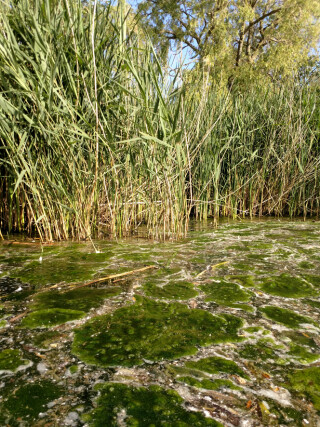
But a more long-term solution, and an idea that is gaining momentum locally, is to take existing farmland out of agricultural production and turn it into nature reserves against which developers could buy credits to offset their nitrate emissions. This summer, Havant went down this route and bought a 148-acre nature reserve at Warblington Farm, near the M27.
“Not only will this innovative scheme unlock thousands of much-needed homes for the local area, but it will provide habitat-rich areas for wildlife in a true win-win,” said environment minister Rebecca Pow on a recent visit to Warblington. No mention was made during her visit of the council’s intention that the full cost will be borne by house-builders in the form of a one-off charge of £1,235 per kilogram of nitrogen.
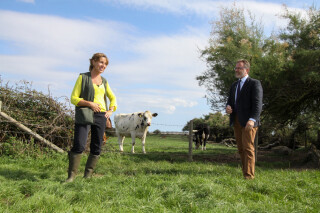
A spokesperson for Havant Borough Council explained that “the amount of mitigation needed varies depending on the wastewater treatment works that the development is served by, although any new home built in Havant Borough would need less than one kilogram of mitigation.”
Natural England is believed to favour this type of solution over the tap-led idea used by Morgan Sindall and in September this year Defra announced a £3.9m fund to set up an online nitrate auction platform through which developers will be able buy credits to create new habitats, such as meadows, woodlands and wetlands, to prevent harmful levels of nitrates reaching the Solent.
The project will run for two years with the results assessed at the end before any wider roll-out. A Defra spokesperson explains: “We are proposing to set up a nutrient trading process to enable developers in need of nitrogen mitigation solutions to connect via an online platform with land managers able to provide such solutions. For example, farmers who are willing to take some of their land out of intensive agricultural production and commit it to meadow, woodland or wetland for at least 80 years.”
The big question – the likely cost of each credit via this reverse auction system – currently remains unclear; Defra says it’s too early to be precise.
Meanwhile, the Hampshire & Isle of Wight Wildlife Trust spent £950,000 earlier this year buying an arable farm at Wootton on the Isle of Wight. The Trust plans to ‘rewild’ the farm in order to offset the impact of 600 new homes to be built in Fareham, on the mainland. Again, developers will be able to buy credits to offset their nitrate emissions.
John Durnell, the Trust’s head of conservation, says that “with legal fees, the cost is probably around £4,000 per unit, but if you have 100 houses, and the legal and admin fees were the same, it would probably come out at around £3,000 per unit.”
The Trust is working with regional house-builders as well as more than 40 small to medium-sized firms. “We’ve got a lot of flak for dealing with what people see as rapacious house-builders but a lot of these guys are desperate and their options are running out,” says Durnell. SMEs are sitting on options for land and desperately searching for solutions in order to start work, but not finding any answers.
Mark Adams, chairman of New Forest-based house-builder Pennyfarthing says: “We’re getting smaller developers ringing me because they don’t know what to do. They’re saying ‘if you can find a way of buying nitrates can you let me know?’”
Pennyfarthing works across the region but is facing delays in the New Forest as there is nowhere at present to buy credits in the area. As a result, housing schemes are being logjammed at New Forest District Council (NFDC), which has the dubious distinction of having been rated the UK’s worst local authority for designating sufficient land for new homes over the past three years.
“Progress has been made but as a local planning authority we have not reached a position yet whether we can offer a tailor-made short-term solution to developers for them to buy into,” said an NFDC spokesperson.
Yet another solution to the problem on larger developments could be for the developer to construct small water treatment plants that reduce nitrates before they enter the main sewage system. But of course, this would only be viable on schemes of a certain size and wouldn’t be viable for a small housing development of just a handful of units.
From ‘tap-led solutions’ to building wetlands to rewilding farmland, there is no single solution that offers a panacea – and unfortunately no one is taking the lead in finding one. “It’s all a mess,” says Adams. “Part of the problem is that no one is taking responsibility. With all the smoke and mirrors, no one is answering any questions. We are trying all the time to get clarification.”
This frustration is shared well beyond the New Forest. Throughout the industry there is a tacit acceptance that nitrate pollution in the Solent is just the start. “The Solent is not the only place with nitrates and it could hypothetically apply anywhere in the UK,” says Christian Silk. John Durnell agrees: “It’s not beyond reason to think this is going to be a wider problem,” he says.
Other instances of nitrate pollution have occurred in Somerset and Herefordshire, and Durnell expects the problem to extend beyond the Solent coastline as far as Sussex and Kent. And nitrates won’t be the only problem.
The same directive also applies to other types of pollution, notably phosphates, which are already a problem in Hampshire’s River Avon and could yet be more widespread than nitrates.
Cash-strapped local authorities will also soon realise that nitrate pollution also offers an opportunity to levy a further charge on house-builders. What started as a small local issue now has the potential to become a mini industry at the expense of construction.
This article was first published in the Oct/Nov 2020 issue of The Construction Index magazine. Sign up online.
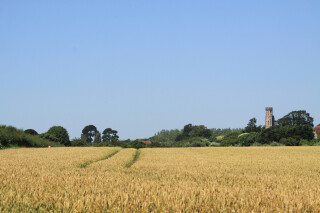
Got a story? Email news@theconstructionindex.co.uk

